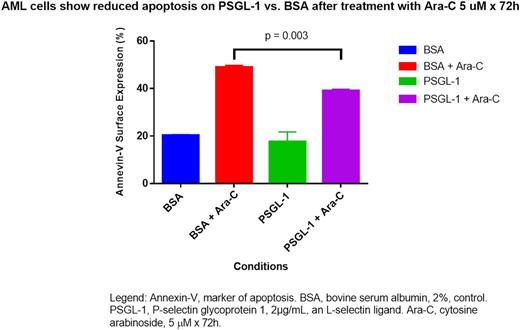Abstract
Introduction: Acute myeloid leukemia (AML) arises in the bone marrow microenvironment (BME), where cell-cell and cell-matrix adhesion promote AML survival. There is increased incidence of AML in older adults and age-related changes in the BME such as the senescence associated secretory phenotype (SASP) may promote myeloid disorders and cancer. Our objective is to further elucidate the influence of the BME on AML pathobiology.
Methods: Using flow cytometry, we prospectively characterized 17 cell adhesion receptors expressed on AML blasts derived from 106 patient blood and bone marrow samples on an IRB approved protocol. For 55 patients, we correlated expression of these individual adhesion receptors with age, cytogenetics, complete remission (CR), relapse free survival (RFS) and overall survival (OS). We correlated expression of adhesion receptors with basal levels of DNA damage in AML blasts, as measured by phosphorylation of histone H2AX (γ-H2AX) by flow cytometry. mRNA microarray gene expression profiling (GEP) on 30 patients, we examined for age-associated differences in the gene expression of cell-cell and cell-matrix adhesion proteins. For 6 patients, we evaluated for changes in GEP that occur in AML blasts with adhesion to plates coated with alternative spliced fibronectin peptide CH296, RetronectinTM (RN) vs. bovine serum albumin (BSA) control.
Results: We found a significant positive correlation between L-selectin cell surface expressed protein levels with advancing age (Spearman r = 0.35, p = 0.009) (Figure 1). The response to treatment (CR/CRi) rate, but not RFS, increased with greater surface expression of the following adhesion proteins: CD11a (αL), CD29 (β1), CD44, CD49a (α1) and CD49e (α5). OS improved with greater cell surface expressed protein levels of CD11a (αL) and CD29 (β1).
There was a significant negative correlation in L-selectin mRNA levels with basal DNA damage in AML blasts, as measured by γ-H2AX (Spearman r = -0.6, p = 0.005). To further investigate the relationship between L-selection expression and DNA damage in AML, we cultured AML blasts on an L-selectin ligand, P-selectin glycoprotein-1 (PSGL-1) vs. BSA control. We observed increased blast survival and reduced apoptosis when adherent on PSGL-1 compared to BSA after treatment with cytarabine arabinoside (Ara-C) in 4/15 (27%) of samples tested (Figure 2).
Ingenuity Pathway Analysis (IPA) results on the gene expression data showed age-associated changes in the expression of L-selectin and cell-matrix proteins involved in the SASP, such as tissue inhibitor of metalloproteinases (TIMP). Adhesion of AML blasts to RN vs. BSA control resulted in up-regulation of genes involved in protein ubiquitination and the PI3K/AKT, nuclear factor-kappa beta (NF-kβ) and IL-8 signaling pathways.
Conclusions: Age-related changes in the expression of L-selectin, cell-cell and cell-matrix proteins in AML blasts appear to influence DNA damage signaling/response (DDR), promote Ara-C resistance, and influence patient response to treatment and survival. Adhesion of AML blasts to the BME results in up-regulation of cell survival pathways that confer resistance to apoptosis and maintenance of the SASP. Our results support disruption of L-selectin and other BME-mediated interactions as potential targets to enhance cytotoxicity to chemotherapy and improve age-specific outcomes in AML.
Becker:Invivoscribe: Honoraria; CVS Caremark: Other: Accordant Health Services Medical Advisory Board; Millennium: Research Funding; Amgen: Research Funding; Abbvie: Research Funding; Glycomimetics: Research Funding; Pfizer: Other: Scientific Steering Committee for a post marketing study; JW Pharmaceutical: Research Funding.
Author notes
Asterisk with author names denotes non-ASH members.



This feature is available to Subscribers Only
Sign In or Create an Account Close Modal